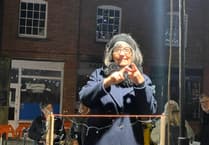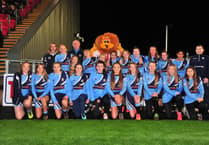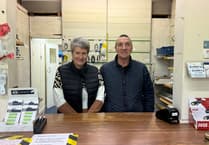THORVERTON and District History Society visited Dunkeswell Airfield on June 18.
The weather at Dunkeswell in the Blackdown Hills turned out to be very much in our favour as we assembled near the Southwest Airfields Heritage Centre for a talk about the history of the RAF, the US Army AirForce and the US Navy Airforce which all flew, in that sequence, from the airfield newly-built by the George Wimpey Company in 1942-3.
It was first commissioned by RAF Coastal Command in 1943.
We found the airfield a hive of activity with private aircraft and motorised gliders taking off frequently.
The attention of many visitors, however, was drawn to the double-cockpit, trainer Spitfire being chartered for flights by enthusiasts.
The sight of the iconic aircraft at close quarters was thrilling, as was the characteristic roar of its Merlin engine as it carried a few fortunate passengers for a spin over the Blackdown Hills.
Historians amongst us were fully aware of the greater numerical role of the Hurricane in many of the theatres of combat in WWII, including the Battle of Britain, but it was difficult not to be moved by the sheer beauty of Spitfire’s wings and fuselage.
Our host for the day, Brian Lane-Smith, chairman of Southwest Airfields Heritage Trust, welcomed us in the cabin of the Heritage Centre, and gave a polished introduction to the history of aviation at Dunkeswell.
A prepared film illustrated the purpose of the aircraft flying from one of the very few flat hilltops in the South West.
In the early 1940s, the Axis Powers had determined to blockade the British Isles and cut off its food supplies from North America and starve it into submission.
While the surface ships of the Kriegsmarine were outnumbered by those of the Royal Navy, the fleet of U-boats was much less easily countered, especially as the fall and occupation of France early in the conflict make it possible to base submarines in heavily defended pens lining the Bay of Biscay.
The Battle of the Atlantic in the years 1940-42 saw catastrophic losses of merchant shipping as the Allies struggled to counter the U-boat menace.
The U-boat commander, Admiral Karl Dönitz, confidently claimed that his U-boats’ form of attack made them as invulnerable as the mole. However, advances in technology and the air forces of the United States were to prove him wrong.
For it was at this time that the United States sent to Britain fleets of VLR (very long range) B24 Liberator aircraft specially modified for marine patrol work equipped with centimetric radar, which was sensitive enough to detect objects as small as conning towers and periscopes just above the sea surface while the U-boat itself was submerged.
After his introduction, Brian spoke about the many exhibits of WWII photographs and texts lining the Centre and showed us models of Liberators and the fighter-bomber Junkers JU88, which were the Liberators main adversary on patrols that came nearer to Luftwaffe coastal airfields. If JU88s were spotted in time, the Liberators could sometimes turn out to sea to take them beyond the fuel-limited range of the bomber-fighters.
Brian also emphasised a key difference in the policy on taking photographs between the RAF and the US services at Dunkeswell.
While the RAF prohibited unauthorised photographs, US commands were much more relaxed on the issue, with the result that there is a rich photographic archive of their time at the airfield.
Brian explained the patrol grid (code-named Percussion-T) that dominated the flying time of the Liberator crews. It was known that U-boats had to surface for air and to recharge their batteries, and that the process took approximately 30 minutes.
It was calculated that the relevant area of the Bay of Biscay could be patrolled on a grid with each return flight displaced laterally by 10 miles from its previous transect. This routine was followed by day, and later by night, as advances in radar technology made low-level flight over the sea at night feasible.
Brian showed us models of some of the ingenious weapons designed to damage U-boats including depth charges designed to detonate just below the surface, and an acoustically-guided torpedo, “Fido”, designed to circle a submarine, pick up its bubble noises and finally home in on the craft.
Brian explained that many air crew could spend months of missions while barely ever seeing a submarine, and emphasised that the goal was not so much the destruction of the U-boats as preventing them from reaching the merchant convoys in mid-Atlantic.
By discouraging U-boats from their preferred travel on the surface at about 17 knots, they were confined under water at the much slower speed of about 6 knots, which took them much more time and fuel and reduced their operational range.
There were many fine flying crews at the time practiced at the long, usually unrewarding, 10-12 hour missions over the Atlantic, some at dangerously low altitude.
On their return, the tired crews had to face the notoriously bad winter weather of the West of England and a few joined the tragic tally of flights that ended in crashes on the tors and bogs of Dartmoor.
One of the highly experienced pilots was Joseph Kennedy jnr. the older son of Joseph Kennedy snr, the wealthy, powerful Democratic politician, who served at that time as US ambassador to the United Kingdom. Joseph snr was hugely ambitious for his sons, Joseph, John and Robert, and groomed them for life in politics when the war was over. His oldest son, Joseph jnr was highly ambitious in his own right and shared his father’s vision for him as a candidate for the US presidency.
In 1944, Joseph jnr saw himself coming to the end of a successful but relatively uneventful tour of duty without a decoration that would give him prestige in politics. It is said that his ambition was made fiercer when his younger brother, John, was awarded the Navy and Marine Corps Medal for heroically rescuing fellow sailors following the sinking of his PT-109 in the Asian theatre of war, a feat which instantly made him a war hero.
While Joseph was still at Dunkeswell, a hazardous bombing mission was conceived to deliver an aircraft loaded with explosives to the site of the giant V3 accelerating cannon near Mimoyecques in the Pas-de-Calais region that was beginning to shell London from the other side of the channel with disastrous effectiveness.
There was much competition among senior pilots to be chosen for this mission, which involved taking off with the loaded aircraft and parachuting from it leaving guidance planes to direct it remotely to its target.
The more senior and responsible candidates were forced to withdraw their applications, which provided Joseph with the yearned-for opportunity to earn the DFC, which was promised to those who succeeded in the mission.
In August 1944 a B-24 Liberator loaded with Torpex explosive took off from an airfield in Norfolk piloted by Kennedy and his co-pilot Wilford Willy. In flight, the arming pin was removed to prepare the payload, but it then detonated prematurely producing a huge blast over Blythburgh, which damaged scores of buildings though without causing casualties on the ground.
Kennedy and Willy were awarded posthumous Air Medals and Navy Crosses. The bereaved father, Joseph snr, then transferred his presidential ambitions to his second son, John.
We had opportunity to admire the displays and exhibits, though we needed much more time to do them all justice.
Brian then took us on a conducted tour of the airfield and showing us the layout of the runways, the former sites of hangers, the location of a subterranean command post and the still-surviving control tower, now repurposed as an office block.
After group photographs at the end of the principal runway, we repaired to The Aviator Café for a reserved lunch and for excited conversation about what we had seen.
This was accompanied by the intermittent background roar of a Merlin engine as the Spitfire took lucky passengers for their circuits beneath a bright blue sky.
K A Marshall





Comments
This article has no comments yet. Be the first to leave a comment.